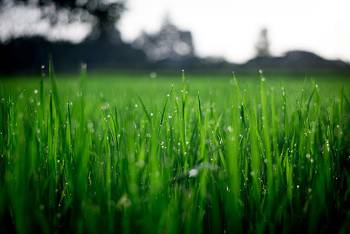Spring Lawn Care

Spring is a time of warming temperatures, blooming flowers and the smell of fresh cut grass. On those warm days it can be tough not to spend time in your yard, watering, fertilizing, mowing, watering again, and it brings up a question. Is all this work really necessary right now? The answer is, not at all!!! Here are a few “lawn commandments” to follow.
Thou Shalt not Fertilize Heavily
The use of fertilizers in the spring is really not necessary and could be eliminated completely. Fertilizer, if applied incorrectly can run off down the road during those heavy spring rains and pollute streams, rivers and other bodies of water. The only lawns that need fertilized are those that will be on a regular watering schedule during the summer. Spring fertilizer applications can lead to fast shoot growth at the expense of your roots which reduces drought tolerance. The best time to fertilize is in the fall before the grass goes dormant in the fall. One downside to not applying fertilizer in the spring is that many times crabgrass preventer is mixed in with fertilizer and it can be hard to find just plain crabgrass preventer. You can find it, but you may have to look harder. If your local garden center doesn’t carry it, you could ask that they carry it in the future, not applying fertilizer will save you watering in the summer. If you can’t find crabgrass preventer without fertilizer, you should still apply it, but make it your only fertilizer application for late spring/early summer. For best crabgrass control, you do need rain within a couple days of application or you will need to water the preventer in.
Thou Shalt Not Water (Unless it is absolutely Necessary)
In the spring, our yards will put out a big flush of growth so you will mow, but that doesn’t mean you need to be watering! Even as dry as things were before the rain, watering wouldn’t have been necessary. Most soils still had enough water to support the grass. Another factor is that allowing your grass to get a bit dry in the spring is good for it. Being dry will help the grass tolerate drought and heat in the summer. Grit your teeth and leave the hose coiled up, you will be doing your lawn a favor by providing tough love. When you do need to water, the key is water deeply and infrequently. Try to put down ¾” to 1” of water each time you water, your soil should be moist down 6-8” from the surface. This type of watering encourages deep root systems which help the plant survive drought times. This type of watering also helps keep weeds at bay since the top layer dries and weed seeds don’t sprout.
Thou Shalt Not Scalp Your Lawn
I know, it is very tempting to lower your lawn mower and take off all of that dead material from your lawn, but don’t. Scalping your lawn at any time sets your lawn back in several ways. First it opens the canopy so light hits the weed seeds and they start to germinate. (A bit counterproductive if you are trying to keep weeds out.) Low mowing also damages the growing points of the grass and can potentially cause harm if a late spring freeze comes along. Instead of mowing really short, only drop the mower one notch for the first mowing of the season. This will help remove some of that top unsightly layer. After that mowing, return your mower blades to the recommended height for your grass.
Thou Shalt not be Annoyed by Lush Spring Growth
Spring is a time when the temperatures are conducive to growth in our lawns and they will grow by leaps and bounds. Don’t let it stress you out or get you down. Be sure your mower blades are sharp and always follow the 1/3 rule. Never remove more than 1/3 of your grass leaf at any time, no matter what time of year. If you have a fescue or bluegrass yard, keep your mower blades set at 3” for most of your spring mowing’s. Don’t let your spring mowing regimen become too complicated, keep it simple. Spring lawn care doesn’t have to be difficult.

